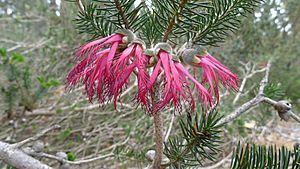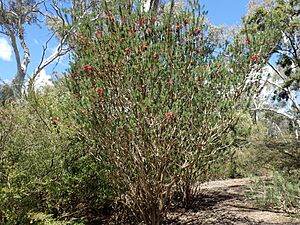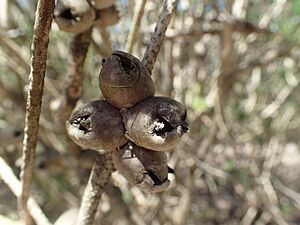Mouse ears facts for kids
Quick facts for kids Mouse ears |
|
|---|---|
 |
|
| Calothamnus rupestris in the Jarradale State Forest | |
| Scientific classification | |
| Genus: |
Calothamnus
|
| Species: |
rupestris
|
| Synonyms | |
|
Melaleuca rupestris (Schauer) Craven & R.D.Edwards |
|
Calothamnus rupestris, also known as mouse ears or granite net-bush, is a special plant found only in the south-west of Western Australia. It belongs to the myrtle family, called Myrtaceae. This plant can be a shrub or a small tree. It has short, stiff, and prickly leaves. In spring, it shows off beautiful pink to red flowers.
Contents
What Does Calothamnus rupestris Look Like?
Calothamnus rupestris is a plant that grows upright. It can be a compact shrub or a small tree. It usually reaches a height of about 0.9 to 4 meters (3 to 13 feet). Its leaves are about 20 to 25 millimeters (0.8 to 1 inch) long. They are stiff and round like a pencil. Each leaf ends in a sharp, prickly point.
The flowers of this plant are pink to red. Unlike some other plants in its genus, its flowers are not hidden by thick, corky bark. The plant has four sepals, which are like small leaves that protect the flower bud. These sepals are very hairy on the outside. It also has four petals and four claw-like bundles of stamens. Stamens are the parts of the flower that make pollen.
This plant flowers from July to December. After the flowers, it produces woody capsules, which are like seed pods. These capsules are usually 15 to 20 millimeters (0.6 to 0.8 inches) long and 13 to 18 millimeters (0.5 to 0.7 inches) wide. The capsules have four thick parts, and two of them stick out like a bird's beak.

How Calothamnus rupestris Got Its Name
The plant was first officially described in 1843 by a scientist named Johannes Schauer. He wrote about it in a book called Dissertatio Phytographica de Regelia, Beaufortia et Calothamno.
The second part of its scientific name, rupestris, comes from a Latin word. This word means "of rocks" or "rocky." This name fits well because the plant often grows on rocky places.
Where Calothamnus rupestris Lives
Calothamnus rupestris is found in several places in Western Australia. You can see it in the Perth suburbs of Red Hill and Gosnells. It also grows in the Boyagin Rock Nature Reserve.
This plant is found in different natural areas, including the Avon Wheatbelt, Jarrah Forest, and Swan Coastal Plain. It likes to grow on granite rocks and hillsides.
How Fire Affects Calothamnus rupestris
Scientists have studied how fire impacts Calothamnus rupestris. They found that this plant can recover from fires. It does this by using seeds that are stored inside its woody fruits.
However, it takes about 7.5 years for the plants to produce these woody capsules with seeds. This means that if there are frequent, very hot fires, the plants might not have enough time to make new seeds. If fires happen too often, it can kill off groups of this plant. Luckily, because this plant lives on rocky outcrops, it is somewhat protected from less intense fires.
Protecting Calothamnus rupestris
The Western Australian Government's Department of Parks and Wildlife has looked into the status of Calothamnus rupestris. They have classified it as "not threatened." This means that currently, there are enough of these plants, and they are not in danger of disappearing.
See also
 In Spanish: Calothamnus rupestris para niños
In Spanish: Calothamnus rupestris para niños


